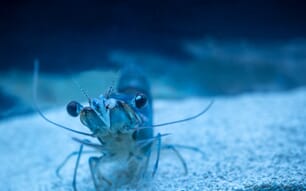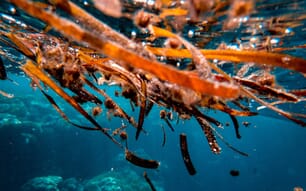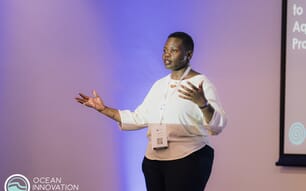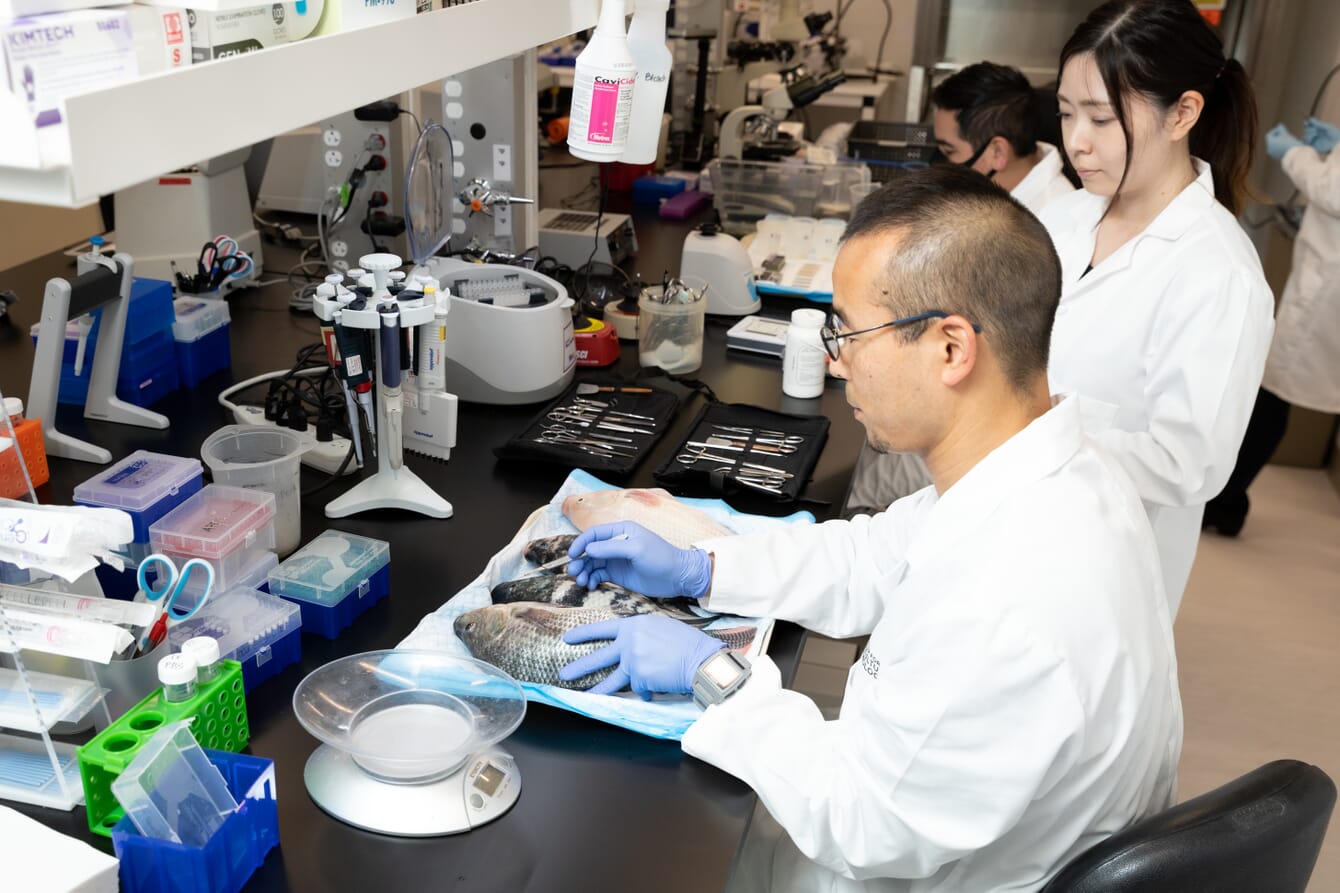
© CAT
This is the firm belief of Xavier Lauth and John Buchanan, respectively the director of innovation and the CEO of the Center for Aquaculture Technologies (CAT), a company which has been at the forefront of developing gene editing techniques across a wide range of aquaculture species.
“GE research in finfish – notably in tilapia – is most advanced, but some early-stage work is also underway in shrimp and oysters. At CAT, we are commercialising 100 percent sterility in farmed fish through genome editing. We see sterility as necessary prerequisite to the commercialisation of other beneficial genome edits in aquaculture. Farmed fish that are 100 percent sterile also provide a solution to governmental regulation of GE technology, offer environmental benefits through preservation of biodiversity, and improve productivity and economics,” reflects Buchanan.
Lauth agrees, pointing to the nutritional demands of the growing global population as the primary incentive for using gene editing.
“It’s not just a case of increasing food production, we must also take our declining resources and climate change into account and re-evaluate what food we need to produce and how it needs to be produced, with a focus on nutrition and production efficiencies,” he observes.
Genome editing explained
While GE may polarise public opinion, Lauth – who has been using the technology since 2012 – offers a very clear argument for why it should be embraced. This is based firmly on his understanding of the scientific process and the fact that it is a process that occurs naturally on a regular basis.
“Genome editing is essentially a set of very precise and programmable tools that we can use to rewrite the genetic code of a living organism. It’s a natural system that evolved in bacteria 1 billion years ago, to help them fight viruses. It has now been repurposed and optimised in different versions, including CrispR-Cas9 to work in plant and animal cells. The technology creates genetic variation that could occur naturally. Initially it was used to deactivate genes with great precision and efficiency but now we can actually rewrite the genome over a specific stretch of DNA and swap a non-ideal version for a good one and fix genetic issues at the roots,” he explains.
“At the core gene editing was initially a discovery and became a series of inventions that now have very far-reaching applications in biotechnology, agriculture and in medicine. It has created a new world in which we can drive amazing improvements in healthcare and food production, among other applications,” he adds.
The use of GE in aquaculture
According to Lauth, over 25 aquaculture species have so far been successfully gene edited, but tilapia have been the subject of the most research in this field to date – due to their robust nature, fecundity and short generation time.
Meanwhile, in terms of traits, sterility, gender determination, yield, growth, pigmentation and disease resistance have dominated scientific research in this field.
“Scientists, including our team at CAT, are working on two main types of research. The first is GE that will create variation in genes leading to improvement in commercial performance, leading to advances in economics and sustainability of fish farming. The second is building the tools to conduct GE on a commercial scale in finfish and shellfish. Such tools are necessary to effectively deliver GE to the global industry. The potential of GE is to increase genetic progress by orders of magnitude greater than is achieved in conventional breeding for key traits. Such improvement in growth, efficiency and disease resistance will revolutionise industry strategy for genetic improvement, and the speed with which genetics can address the changing needs of the aquaculture industry,” Buchanan explains.
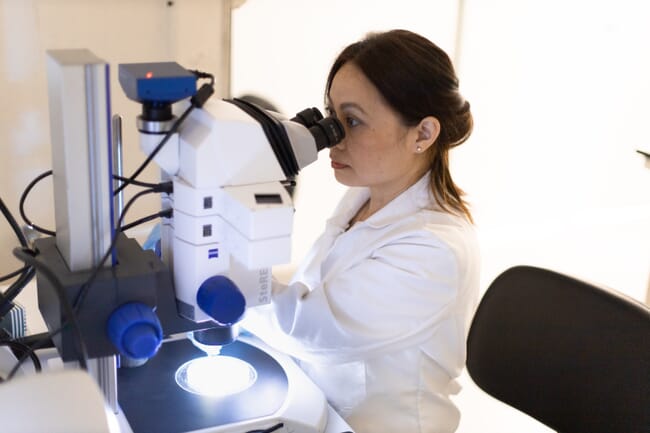
© CAT
Milestones in aquaculture GE
According to Lauth, CAT’s first gene editing breakthrough was the production of tilapia without pigmentation in 2012, while in 2018 they achieved the large-scale production 100 percent sterile tilapia, from a population of single-sex fish.
“It answered a dilemma that farmers have: they want fertile fish in their breeding programmes but infertile fish for production, and patents have now been filed in more than 20 countries across five continents. We’ve also shown that sterility improves performance, because energy that would have been diverted to reproduction is used instead for growth,” he explains.
In 2019 – the year they were acquired by Cuna del Mar – CAT launched a new initiative to improve animal welfare, yield and growth.
“Recently generated data that shows a remarkable 33 percent growth increase in tilapia at eight months of age, when compared to their non-edited siblings. This was achieved by optimising the balance between food intake and energy expenditure,” notes Lauth.
Investment by Cuna del Mar has allowed them to expand and open state-of-the-art tilapia and shrimp R&D research facilities.
More recently, Lauth points to the pioneering feasibility trials for gene editing in vannamei shrimp, as conducted by Ashutosh Pudasaini and Tuong Tran.
“It was a difficult task – handling shrimp eggs is a major issue, as they are very small and very fragile – and took \ years of tedious effort but they now have a system that works very efficiently and we’re very proud of their achievement,” he explains.
GE regulations
While GE divides public opinion and national regulations, Buchanan and Lauth see it as becoming increasingly accepted.
“Some countries have now relaxed or deregulated GE regulations as a natural form of creating genetic variation, so there’s a trend towards acceptance of gene editing, but there are still gaps between science and policy governance and management of GE products and there’s a need for harmonisation of GE regulation frameworks,” notes Lauth.
Buchanan points to a number of regulatory and scientific advances.
“A genome edited tilapia for improved yield from AquaBounty has been deregulated in Argentina and Brazil. Though it is not currently farmed, it could be. In Japan, a genome edited red sea bream and tiger puffer have been approved and are farmed in RAS facilities and sold into commerce by Regional Fish Company, but production volumes are small. GE is already being used in human medicine to cure diseases caused by faulty genes. Pig breeders have developed GE strain of pigs resistant to an endemic virus causing piglet mortality,” he explains.
“Most governmental regulatory agencies understand that GE is indistinguishable from natural genetic variation and no foreign DNA is introduced. GE is being regulated differently to GMO, transgenics or other biotechnologies in many markets. This is critical in moving this technology to commercialisation. CAT sees introduction of sterile GE fish as the catalyst for releasing the potential benefits of this technology. We have invested in finfish and shrimp genome editing facilities, and are going to market with a genome editing sterility solution,” he adds.
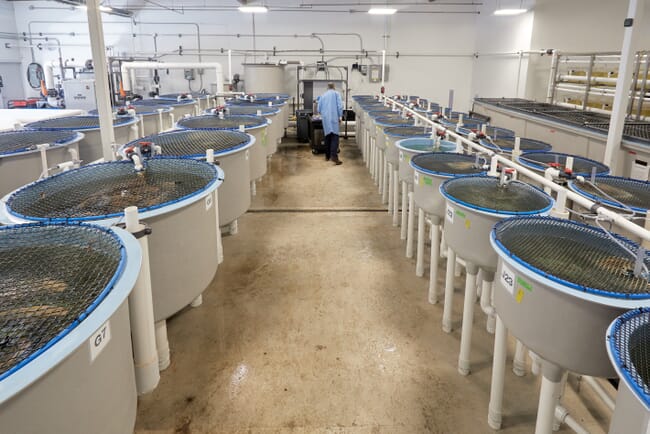
© CAT
Social licence
As food security and environmental challenges have become mainstream concerns, so consumers are becoming more receptive to the benefits of GE, according to Buchanan.
“Where GE is demonstrated to deliver benefits to the fish, the environment, the consumer and the producer, then consumers will accept the technology. CAT sees that most consumers are ready for the solutions the technology offers; we will continue to communicate the benefits of GE in all aspects of fish farming,” he argues.
Meanwhile Lauth recommends engaging with regulators, farmers, policy-makers and the public to discuss the risks and benefits of gene editing technology.
“We need to explain better that changes to the genetic code in GE fish are not distinguishable from naturally-occurring DNA changes – which exist by the millions when you compare members of the same species, and they also occur spontaneously every day. On average there’s one mutation every time a cell divides and mutations can lead to dramatic improvements – that’s how evolution works. It’s a naturally occurring phenomena,” he points out.
Commercial viability
Gene editing still relies on techniques which make it expensive to be widely applied to commercial aquaculture, but Lauth envisages that early adopters will understand the potential economic return of implementing the technology offer an attractive return on investment. He points to the massive long-term savings that gene editing could produce.
“If you increase feed conversion efficiency in tilapia by 10 percent it will double the profits of the farmer,” he observes.
However, he is realistic about the timeline.
“One of the challenges is the time it takes to establish these lines. There are species where it will be a slow, grinding process to get the edits and establish the lines, especially for species of fish that take four years to mature. You need to have at least two and likely three generations before you have a commercially relevant integration of your edit into the population,” he notes.
However, having spent 12 years using the technology – a period in which huge advances have been made – he sees the rate of progress as continuing to increase.
“I anticipate breakthroughs in gene editing delivery methods and better understanding of mechanisms that will pave the way for more efficient and precise widespread applications. Cutting-edge techniques like base editing – which can change one DNA letter into another without breaking the DNA strand – will bring new possibilities and unparalleled precision. These are already with us and it’s a really exciting time to be in the industry,” he observes.
In the meantime, CAT are busy ramping up their own work in this sphere.
“We are committed to bringing GE to commercial application for a variety of traits and species, and have invested significantly in R&D in this space. In 2024 we will continue to work with commercial partners on 100 percent sterility through GE for fish in commercial production, which will serve as a foundation to adding additional GE traits beneficial to producers and consumers, while supporting environmental stewardship,” Buchanan concludes.

